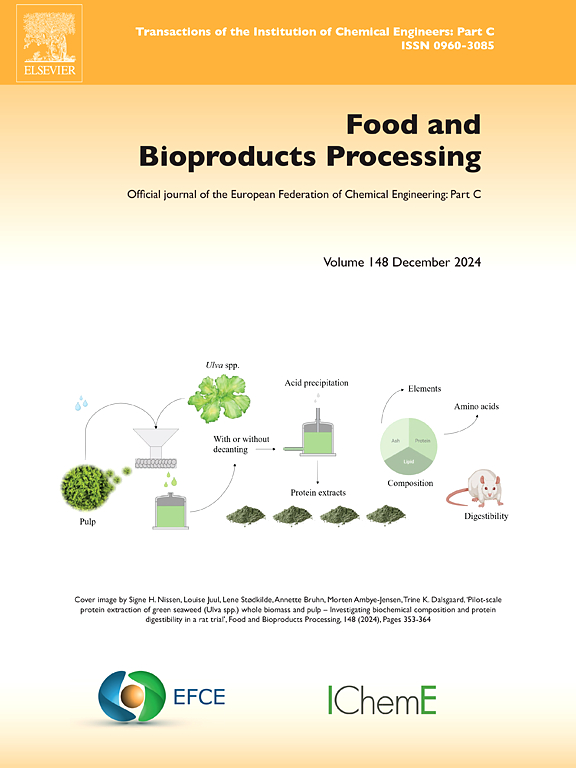Experimental study on the effect of symmetrical heat source on vacuum sublimation-rehydration thawing of large yellow croaker (Larimichthys crocea)
IF 3.4
2区 农林科学
Q2 BIOTECHNOLOGY & APPLIED MICROBIOLOGY
引用次数: 0
Abstract
For vacuum sublimation-rehydration thawing (VSRT), a novel efficient thawing method, the heat source is one of the main factors influencing its heat and mass transfer. The conventional single-sided heat source is prone to localized overheating, which negatively affects the thawing effect. To improve the thawing process, this paper proposed the application of a symmetrical heat source in VSRT, utilizing radiant heating to improve the thawing efficiency. In this study, the large yellow croaker (-18 ℃ and 260 g) was selected as the experimental object. The effects of heating-plate-to-frozen-food distance (DH-F) and heating plate temperature on thawing efficiency and thawing effect were investigated. The results showed that under different conditions of heating plate temperatures and DH-F values, significant variations in thawing efficiency and thawing effect were observed. The optimal operation condition was obtained at both DH-F of 80 mm and heating plate temperature of 35 ℃. Under this operation condition, the fastest thawing rate (3.48 cm/h), the lowest thawing loss (1.15 %), the optimal color, the minimal change in pH, and lower specific energy consumption (7.420 MJ/kg) were achieved. Compared with air thawing, vacuum steam thawing, and VSRT (single-sided heating), the VSRT (double-sided heating) demonstrated superior performance, reducing thawing time by 70.90 %, 7.97 %, and 7.24 %, respectively, while achieving optimal thawing effect and the lowest energy consumption. These findings demonstrate the advantages of symmetrical heat source in improving VSRT and may provide valuable insights for optimizing VSRT systems in food industry applications.
对称热源对大黄鱼真空升华-复水化解冻影响的实验研究
真空升华-再水化解冻是一种新型的高效解冻方法,热源是影响其传热传质的主要因素之一。传统的单面热源容易出现局部过热,影响解冻效果。为了改善解冻过程,本文提出在VSRT中应用对称热源,利用辐射加热提高解冻效率。本研究选择大黄鱼(-18℃,260 g)作为实验对象。研究了加热板到冷冻食品的距离(DH-F)和加热板温度对解冻效率和效果的影响。结果表明,在不同加热板温度和h - f值条件下,解冻效率和解冻效果有显著变化。在焦距为80 mm,加热板温度为35℃时,得到了最佳操作条件。在此操作条件下,可获得最快的解冻速度(3.48 cm/h)、最低的解冻损失(1.15 %)、最佳的颜色、最小的pH变化和较低的比能耗(7.420 MJ/kg)。与空气解冻、真空蒸汽解冻和VSRT(单面加热)相比,VSRT(双面加热)的解冻时间分别缩短了70.90 %、7.97 %和7.24 %,同时取得了最佳的解冻效果和最低的能耗。这些发现证明了对称热源在改善VSRT方面的优势,并可能为优化食品工业应用中的VSRT系统提供有价值的见解。
本文章由计算机程序翻译,如有差异,请以英文原文为准。
求助全文
约1分钟内获得全文
求助全文
来源期刊

Food and Bioproducts Processing
工程技术-工程:化工
CiteScore
9.70
自引率
4.30%
发文量
115
审稿时长
24 days
期刊介绍:
Official Journal of the European Federation of Chemical Engineering:
Part C
FBP aims to be the principal international journal for publication of high quality, original papers in the branches of engineering and science dedicated to the safe processing of biological products. It is the only journal to exploit the synergy between biotechnology, bioprocessing and food engineering.
Papers showing how research results can be used in engineering design, and accounts of experimental or theoretical research work bringing new perspectives to established principles, highlighting unsolved problems or indicating directions for future research, are particularly welcome. Contributions that deal with new developments in equipment or processes and that can be given quantitative expression are encouraged. The journal is especially interested in papers that extend the boundaries of food and bioproducts processing.
The journal has a strong emphasis on the interface between engineering and food or bioproducts. Papers that are not likely to be published are those:
• Primarily concerned with food formulation
• That use experimental design techniques to obtain response surfaces but gain little insight from them
• That are empirical and ignore established mechanistic models, e.g., empirical drying curves
• That are primarily concerned about sensory evaluation and colour
• Concern the extraction, encapsulation and/or antioxidant activity of a specific biological material without providing insight that could be applied to a similar but different material,
• Containing only chemical analyses of biological materials.
 求助内容:
求助内容: 应助结果提醒方式:
应助结果提醒方式:


